coolant level Lancia Thesis 2006 Owner handbook (in English)
[x] Cancel search | Manufacturer: LANCIA, Model Year: 2006, Model line: Thesis, Model: Lancia Thesis 2006Pages: 386, PDF Size: 8.69 MB
Page 137 of 386
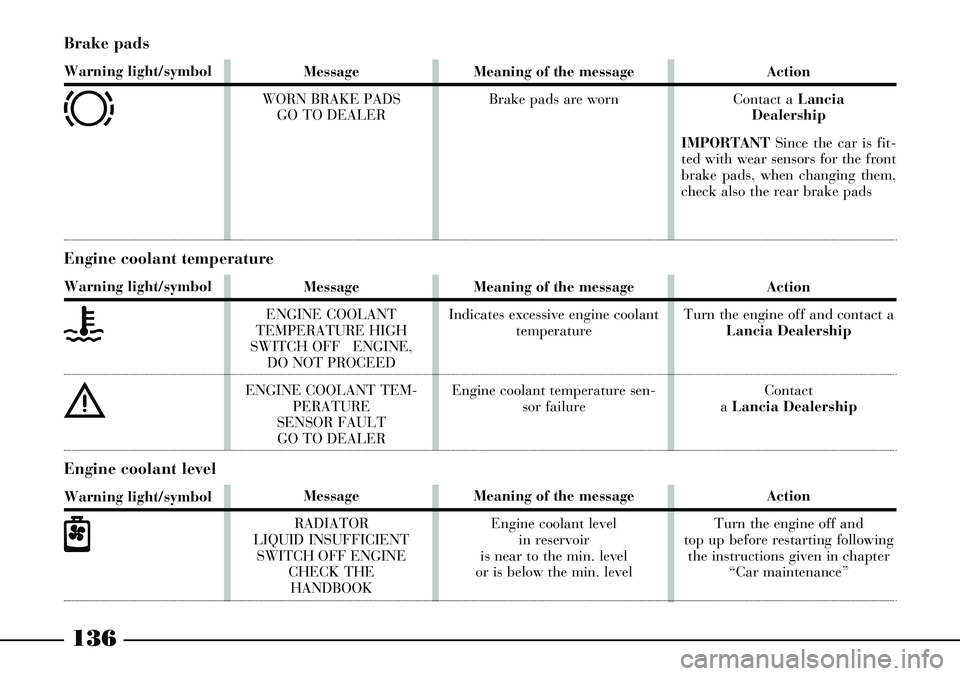
136
Brake pads
Warning light/symbol
d
Message
WORN BRAKE PADS
GO TO DEALERMeaning of the message
Brake pads are wornAction
Contact a Lancia
Dealership
IMPORTANT Since the car is fit-
ted with wear sensors for the front
brake pads, when changing them,
check also the rear brake pads
Engine coolant temperature
Warning light/symbol
u
è
Message
ENGINE COOLANT
TEMPERATURE HIGH
SWITCH OFF ENGINE,
DO NOT PROCEED
ENGINE COOLANT TEM-
PERATURE
SENSOR FAULT
GO TO DEALERMeaning of the message
Indicates excessive engine coolant
temperature
Engine coolant temperature sen-
sor failureAction
Turn the engine off and contact a
Lancia Dealership
Contact
a Lancia Dealership
Engine coolant level
Warning light/symbol
n
Message
RADIATOR
LIQUID INSUFFICIENT
SWITCH OFF ENGINE
CHECK THE
HANDBOOKMeaning of the message
Engine coolant level
in reservoir
is near to the min. level
or is below the min. levelAction
Turn the engine off and
top up before restarting following
the instructions given in chapter
“Car maintenance”
Page 164 of 386
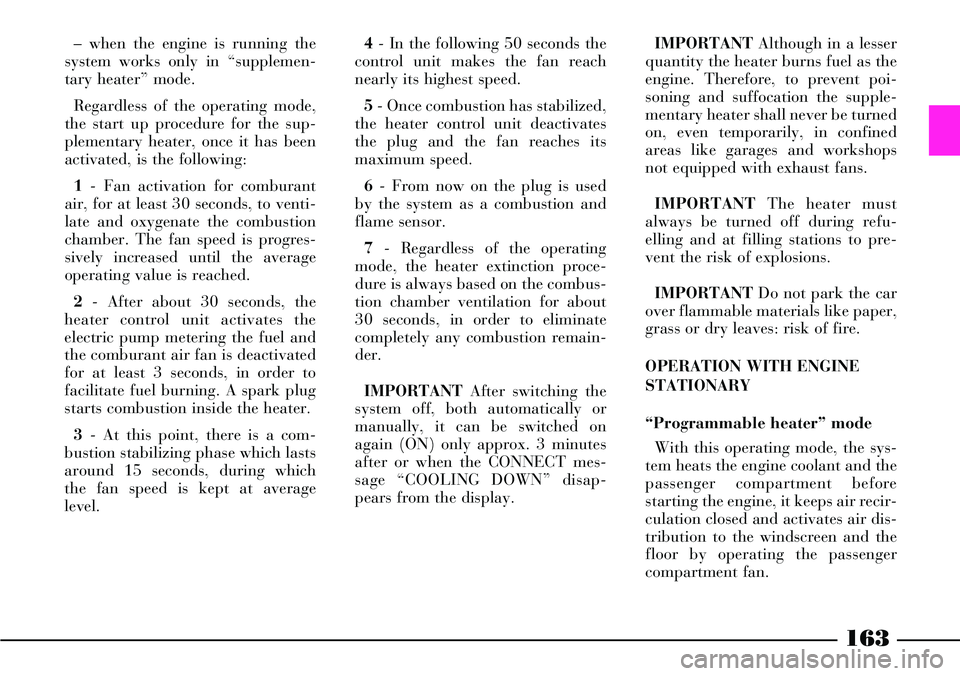
163
– when the engine is running the
system works only in “supplemen-
tary heater” mode.
Regardless of the operating mode,
the start up procedure for the sup-
plementary heater, once it has been
activated, is the following:
1- Fan activation for comburant
air, for at least 30 seconds, to venti-
late and oxygenate the combustion
chamber. The fan speed is progres-
sively increased until the average
operating value is reached.
2- After about 30 seconds, the
heater control unit activates the
electric pump metering the fuel and
the comburant air fan is deactivated
for at least 3 seconds, in order to
facilitate fuel burning. A spark plug
starts combustion inside the heater.
3- At this point, there is a com-
bustion stabilizing phase which lasts
around 15 seconds, during which
the fan speed is kept at average
level.4- In the following 50 seconds the
control unit makes the fan reach
nearly its highest speed.
5- Once combustion has stabilized,
the heater control unit deactivates
the plug and the fan reaches its
maximum speed.
6- From now on the plug is used
by the system as a combustion and
flame sensor.
7- Regardless of the operating
mode, the heater extinction proce-
dure is always based on the combus-
tion chamber ventilation for about
30 seconds, in order to eliminate
completely any combustion remain-
der.
IMPORTANTAfter switching the
system off, both automatically or
manually, it can be switched on
again (ON) only approx. 3 minutes
after or when the CONNECT mes-
sage “COOLING DOWN” disap-
pears from the display. IMPORTANTAlthough in a lesser
quantity the heater burns fuel as the
engine. Therefore, to prevent poi-
soning and suffocation the supple-
mentary heater shall never be turned
on, even temporarily, in confined
areas like garages and workshops
not equipped with exhaust fans.
IMPORTANTThe heater must
always be turned off during refu-
elling and at filling stations to pre-
vent the risk of explosions.
IMPORTANTDo not park the car
over flammable materials like paper,
grass or dry leaves: risk of fire.
OPERATION WITH ENGINE
STATIONARY
“Programmable heater” mode
With this operating mode, the sys-
tem heats the engine coolant and the
passenger compartment before
starting the engine, it keeps air recir-
culation closed and activates air dis-
tribution to the windscreen and the
floor by operating the passenger
compartment fan.
Page 166 of 386
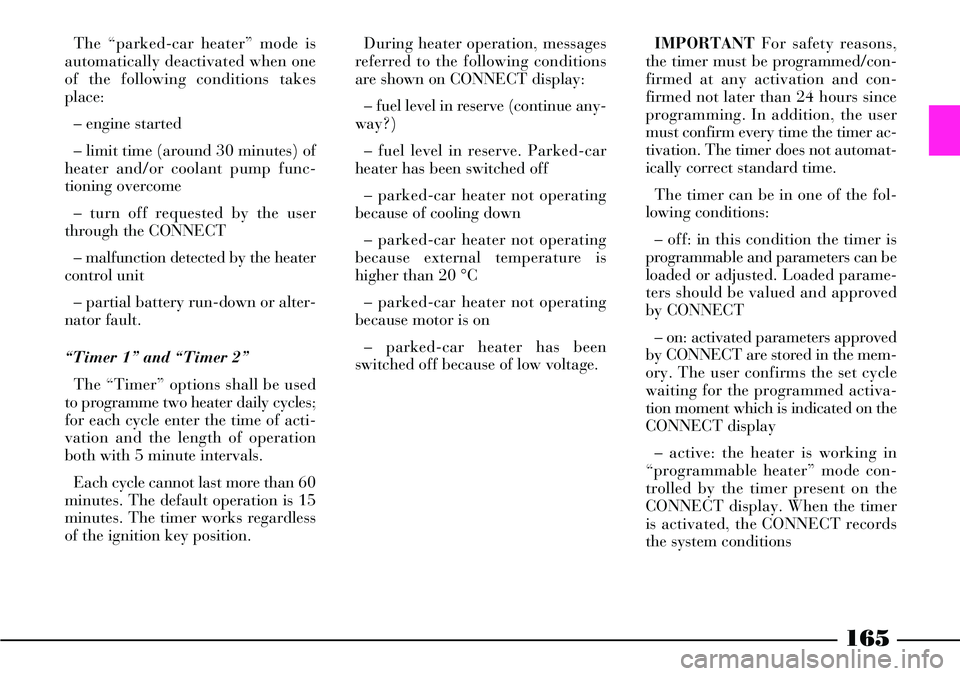
165
The “parked-car heater” mode is
automatically deactivated when one
of the following conditions takes
place:
– engine started
– limit time (around 30 minutes) of
heater and/or coolant pump func-
tioning overcome
– turn off requested by the user
through the CONNECT
– malfunction detected by the heater
control unit
– partial battery run-down or alter-
nator fault.
“Timer 1” and “Timer 2”
The “Timer” options shall be used
to programme two heater daily cycles;
for each cycle enter the time of acti-
vation and the length of operation
both with 5 minute intervals.
Each cycle cannot last more than 60
minutes. The default operation is 15
minutes. The timer works regardless
of the ignition key position.During heater operation, messages
referred to the following conditions
are shown on CONNECT display:
– fuel level in reserve (continue any-
way?)
– fuel level in reserve. Parked-car
heater has been switched off
– parked-car heater not operating
because of cooling down
– parked-car heater not operating
because external temperature is
higher than 20 °C
– parked-car heater not operating
because motor is on
– parked-car heater has been
switched off because of low voltage.IMPORTANTFor safety reasons,
the timer must be programmed/con-
firmed at any activation and con-
firmed not later than 24 hours since
programming. In addition, the user
must confirm every time the timer ac-
tivation. The timer does not automat-
ically correct standard time.
The timer can be in one of the fol-
lowing conditions:
– off: in this condition the timer is
programmable and parameters can be
loaded or adjusted. Loaded parame-
ters should be valued and approved
by CONNECT
– on: activated parameters approved
by CONNECT are stored in the mem-
ory. The user confirms the set cycle
waiting for the programmed activa-
tion moment which is indicated on the
CONNECT display
– active: the heater is working in
“programmable heater” mode con-
trolled by the timer present on the
CONNECT display. When the timer
is activated, the CONNECT records
the system conditions
Page 168 of 386

167
This control is accepted by CON-
NECT only if:
– outside temperature lower than 20
°C
– coolant temperature lower than 50
°C
– the ignition key is at STOPor re-
moved
– car battery charged
– sufficient fuel level
– the timer is deactivated.
Switching the heater on
To switch the heater on, press the
remote control button ONfor 1 or 2
seconds, while keeping the antenna in
vertical position; the positive or un-
successful activation is indicated by
the remote control red led Bin the fol-
lowing way:
– the led turns on for about 2 sec-
onds = the signal has been correctly
received and the heater has been ac-
tivated– the led flashes for about 2 seconds
= the signal has not been received.
In the latter case you are advised to
move before trying to activate it by
pressing again the ONbutton.
After the confirmation activation,
the led Bwill flash every 2 seconds for
the whole operation cycle duration.
IMPORTANTIf led Bturns on with
green colour, press twice both remote
control buttons ONand OFFwithin 1
second to set the red colour.
Activation length
When pressing the remote control
button ONthe last recorded activa-
tion length is always activated.
To see the recorded length, press at
the same time for three consecutive
times within 1 second, the remote
control buttons ONand OFF, count
the number of flashes of led Bthen
compare them to those shown in the
table below, including also the first
flash appearing the third time you
press the buttons. Default activation length is 30 min-
utes but it can be changed through
the following procedure:
– press at the same time for three
consecutive times within 1 second, the
remote control buttons ONand OFF
– count the number of flashes of led
Bincluding also the first flash ap-
pearing the third time you press but-
tons ONand OFF
– press OFFto set the length suc-
cessive to the set one (press OFFfor
several times to set the required
length in sequence)
– wait for about 10 seconds for timer
storing.
Page 256 of 386
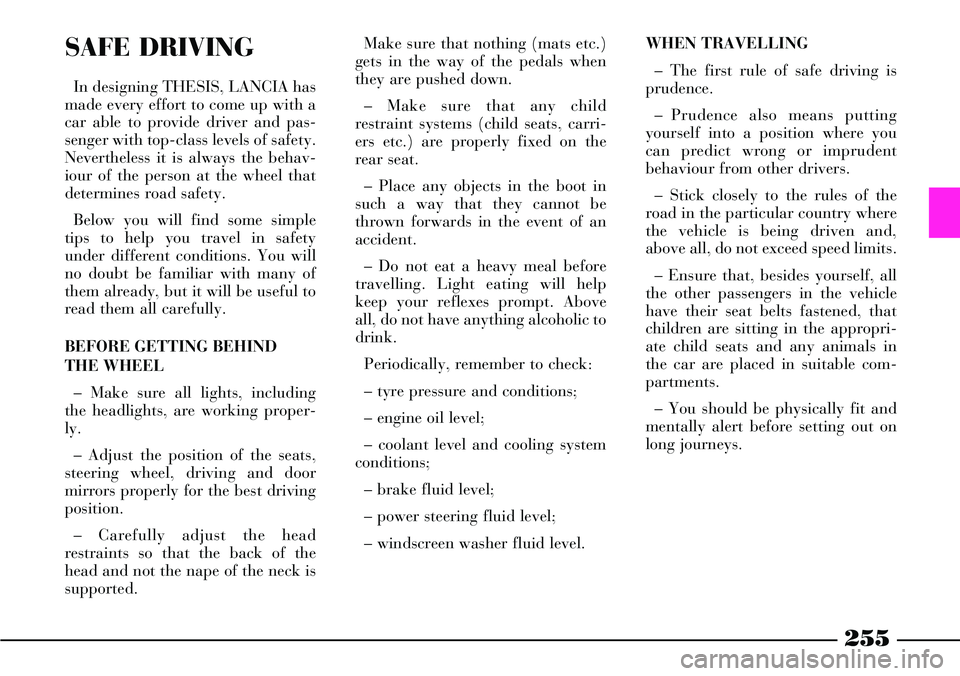
255
SAFE DRIVING
In designing THESIS, LANCIA has
made every effort to come up with a
car able to provide driver and pas-
senger with top-class levels of safety.
Nevertheless it is always the behav-
iour of the person at the wheel that
determines road safety.
Below you will find some simple
tips to help you travel in safety
under different conditions. You will
no doubt be familiar with many of
them already, but it will be useful to
read them all carefully.
BEFORE GETTING BEHIND
THE WHEEL
– Make sure all lights, including
the headlights, are working proper-
ly.
– Adjust the position of the seats,
steering wheel, driving and door
mirrors properly for the best driving
position.
– Carefully adjust the head
restraints so that the back of the
head and not the nape of the neck is
supported. Make sure that nothing (mats etc.)
gets in the way of the pedals when
they are pushed down.
– Make sure that any child
restraint systems (child seats, carri-
ers etc.) are properly fixed on the
rear seat.
– Place any objects in the boot in
such a way that they cannot be
thrown forwards in the event of an
accident.
– Do not eat a heavy meal before
travelling. Light eating will help
keep your reflexes prompt. Above
all, do not have anything alcoholic to
drink.
Periodically, remember to check:
– tyre pressure and conditions;
– engine oil level;
– coolant level and cooling system
conditions;
– brake fluid level;
– power steering fluid level;
– windscreen washer fluid level. WHEN TRAVELLING
– The first rule of safe driving is
prudence.
– Prudence also means putting
yourself into a position where you
can predict wrong or imprudent
behaviour from other drivers.
– Stick closely to the rules of the
road in the particular country where
the vehicle is being driven and,
above all, do not exceed speed limits.
– Ensure that, besides yourself, all
the other passengers in the vehicle
have their seat belts fastened, that
children are sitting in the appropri-
ate child seats and any animals in
the car are placed in suitable com-
partments.
– You should be physically fit and
mentally alert before setting out on
long journeys.
Page 270 of 386
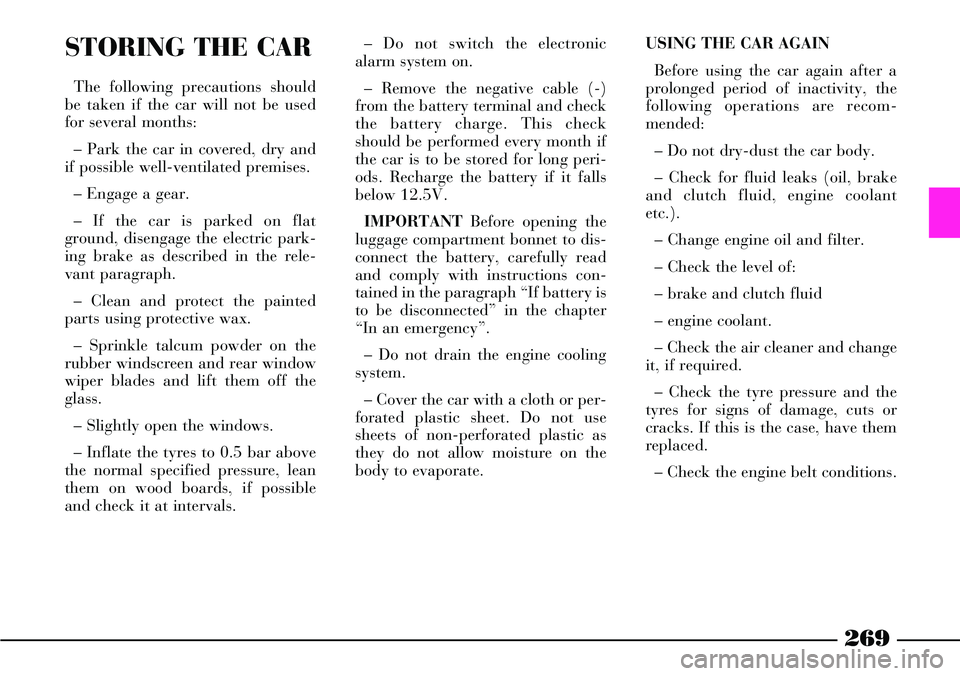
269
USING THE CAR AGAIN
Before using the car again after a
prolonged period of inactivity, the
following operations are recom-
mended:
– Do not dry-dust the car body.
– Check for fluid leaks (oil, brake
and clutch fluid, engine coolant
etc.).
– Change engine oil and filter.
– Check the level of:
– brake and clutch fluid
– engine coolant.
– Check the air cleaner and change
it, if required.
– Check the tyre pressure and the
tyres for signs of damage, cuts or
cracks. If this is the case, have them
replaced.
– Check the engine belt conditions.STORING THE CAR
The following precautions should
be taken if the car will not be used
for several months:
– Park the car in covered, dry and
if possible well-ventilated premises.
– Engage a gear.
– If the car is parked on flat
ground, disengage the electric park-
ing brake as described in the rele-
vant paragraph.
– Clean and protect the painted
parts using protective wax.
– Sprinkle talcum powder on the
rubber windscreen and rear window
wiper blades and lift them off the
glass.
– Slightly open the windows.
– Inflate the tyres to 0.5 bar above
the normal specified pressure, lean
them on wood boards, if possible
and check it at intervals.– Do not switch the electronic
alarm system on.
– Remove the negative cable (-)
from the battery terminal and check
the battery charge. This check
should be performed every month if
the car is to be stored for long peri-
ods. Recharge the battery if it falls
below 12.5V.
IMPORTANT Before opening the
luggage compartment bonnet to dis-
connect the battery, carefully read
and comply with instructions con-
tained in the paragraph “If battery is
to be disconnected” in the chapter
“In an emergency”.
– Do not drain the engine cooling
system.
– Cover the car with a cloth or per-
forated plastic sheet. Do not use
sheets of non-perforated plastic as
they do not allow moisture on the
body to evaporate.
Page 315 of 386
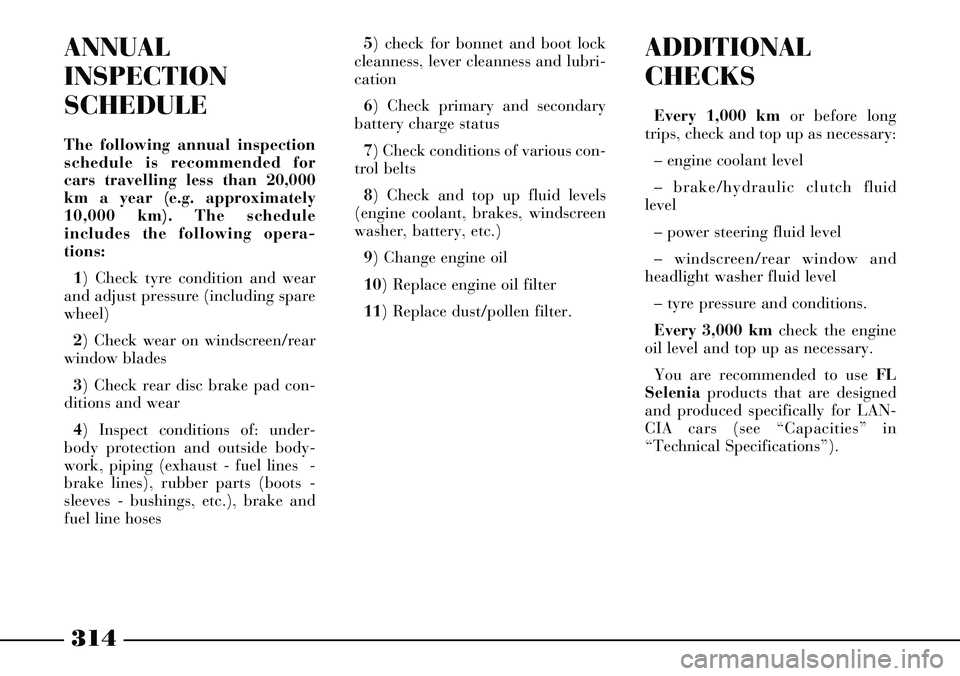
314
ADDITIONAL
CHECKS
Every 1,000 kmor before long
trips, check and top up as necessary:
– engine coolant level
– brake/hydraulic clutchfluid
level
– power steering fluid level
– windscreen/rear window and
headlight washer fluid level
– tyre pressure and conditions.
Every 3,000 kmcheck the engine
oil level and top up as necessary.
You are recommended to use FL
Seleniaproducts that are designed
and produced specifically for LAN-
CIA cars (see “Capacities” in
“Technical Specifications”).
ANNUAL
INSPECTION
SCHEDULE
The following annual inspection
schedule is recommended for
cars travelling less than 20,000
km a year (e.g. approximately
10,000 km). The schedule
includes the following opera-
tions:
1) Check tyre condition and wear
and adjust pressure (including spare
wheel)
2) Check wear on windscreen/rear
window blades
3) Check rear disc brake pad con-
ditions and wear
4) Inspect conditions of: under-
body protection and outside body-
work, piping (exhaust - fuel lines -
brake lines), rubber parts (boots -
sleeves - bushings, etc.), brake and
fuel line hoses5) check for bonnet and boot lock
cleanness, lever cleanness and lubri-
cation
6) Check primary and secondary
battery charge status
7) Check conditions of various con-
trol belts
8) Check and top up fluid levels
(engine coolant, brakes, windscreen
washer, battery, etc.)
9) Change engine oil
10) Replace engine oil filter
11) Replace dust/pollen filter.
Page 318 of 386
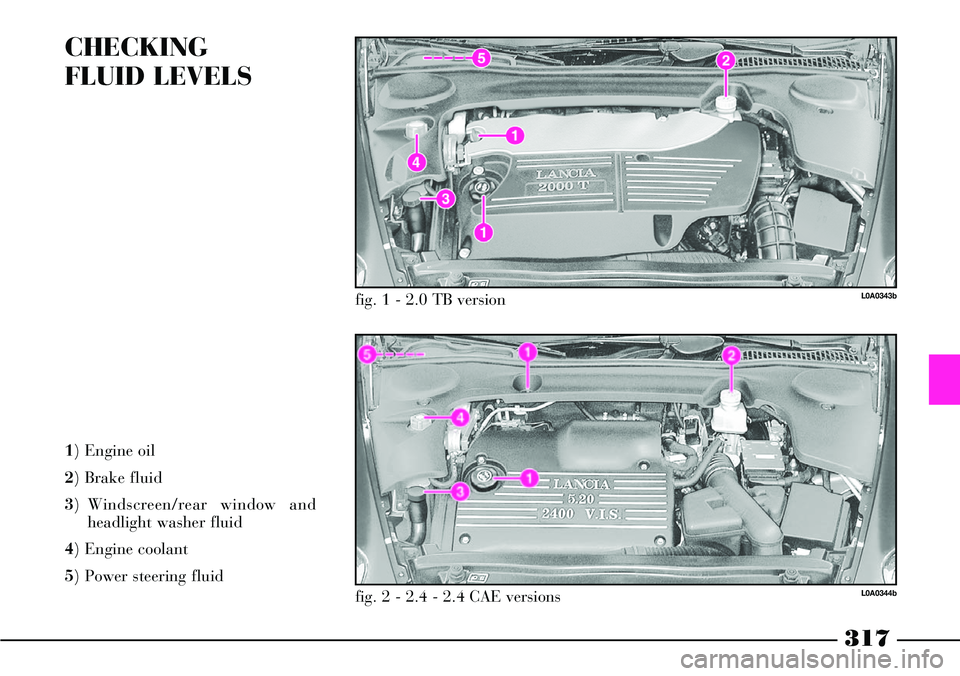
317
CHECKING
FLUID LEVELS
1) Engine oil
2) Brake fluid
3) Windscreen/rear window and
headlight washer fluid
4) Engine coolant
5) Power steering fluid
L0A0343b
L0A0344b
fig. 1 - 2.0 TB version
fig. 2 - 2.4 - 2.4 CAE versions
Page 322 of 386

321
IMPORTANTThe oil consump-
tion depends on the driving style and
the conditions under which the car is
used.Used engine oil and re-
placed oil filters contain
substances which can harm
the environment. We recommend
you have the car seen to at a Lan-
cia Dealership for the oil and filter
change. It is suitably equipped for
disposing of used oil and filters in
an environmentally friendly way
that complies with the law.ENGINE COOLANT (fig. 13)
Do not remove the reser-
voir cap when the engine is
hot: you risk scalding
yourself!
Check coolant level when the engine
is cold and with the car on flat
ground. The level should be includ-
ed between MINand MAXreference
lines on the reservoir.
If the level is low, loosen the reser-
voir cap Aand top up with
PARAFLU UPuntil reaching the
MAXreference line.
fig. 9 - 2.4 JTD version
L0A0324b
fig. 11 - 3.0 V6 CAE version
L0A0155b
fig. 13
L0A0292b
fig. 10 - 2.4 JTD 20V -
2.4 JTD 20VCAE versionsfig. 12 - 3.2 V6 CAE version
L0A0346bL0A0359b
Page 374 of 386

373
- what triggers the alarm
off ..................................... 42
Electronic automatic gearbox
(COMFORTRONIC) ............. 180
- automatic operation ........... 182
- bump starting .................... 188
- failure indication ............... 187
- gearbox display.................. 110
- manual sequential
operation ........................... 186
- moving off ......................... 180
- selecting the automatic/
manual sequential
operation ........................... 182
- sound signal ..................... 188
- starting the engine ............ 180
- stopping ............................. 181
- technical specifications ..... 348
- towing the car ................... 189
Electronic brakeforce
distributor (EBD) .................... 245
Electronic control units
(important) ......................... 330Engine
- identification code ............ 341
- marking ............................ 341
- technical specifications ..... 344
Engine compartment
(cleaning) ............................ 339
Engine coolant ........................ 321
Engine coolant temperature
gauge .................................. 108
Engine oil
- checking level ................... 320
- specifications ..................... 364
Engine oil consumption .......... 321
Engine oil level ....................... 320
Engine warming up ................ 252
Environment
(safety and protection) ......... 4-5
EOBD system ......................... 244
EPB (electric parking brake) .. 175
- emergency disengagement.. 178
ESP system ............................ 189
- ASR function .................... 191- ESP system action ............. 192
- failure indication .............. 192
- initialising the control units
of the door locks, air
conditioner and ESP
system................................ 303
- MSR system ....................... 192
- operation .......................... 190
Exhaust gas
(recirculation system) .......... 7
External lights (controls) ........ 97
Flash consumption
gauge .................................. 109
Flashing the headlights
(main beam) ....................... 100
Fluids and lubricants .............. 364
Follow me home
(delayed light switching off) 99
Front ceiling light ................... 212
- bulb replacement .............. 287